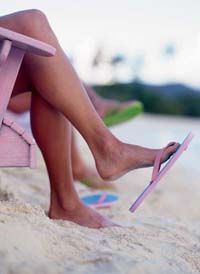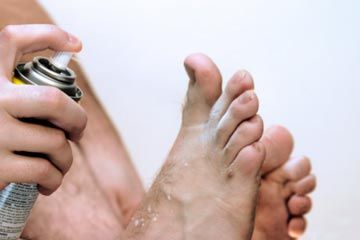Blame the advertising man who misnamed it in the 1930s, but athlete's foot has nothing to do with athletes. It's a fungal infection of the feet. Also known as tinea pedis, or "ringworm of the feet," it has nothing to do with worms either. The Trichophyton fungus that causes the redness, itching, cracking, and scaling of athlete's foot can also infect the scalp, where it causes hair loss and scaly patches; the body, where it causes round, red, scaly patches that itch; and the groin, where the so-called "jock itch" causes itching and thickening of the skin. So what causes athlete's foot?
- Athlete's foot is the most common fungal infection of the skin. It affects more men than women, probably because men typically wear heavy, often airtight shoes, and the fungus loves hot, dark, moist environments.
- Contrary to popular myth, athlete's foot fungus isn't just found in locker rooms, although the moist locker-room environment is perfect for fungal growth. In fact, most people harbor the fungus on their skin, but it's kept in check by bacteria that also normally live on the skin.
- Skin that is irritated, weakened, or continuously moist is primed for an athlete's foot infection. And certain medications, including antibiotics, corticosteroids, birth control pills, and drugs that suppress immune function, can make you more susceptible. People who are obese and those who have diabetes mellitus or a weakened immune system, such as those with AIDS, also are at increased risk. Although anyone can get athlete's foot, teenage and adult males are at the top of the fungus-foot list.
Most cases of athlete's foot cause only bothersome redness, itching, flaking, and scaling on the soles of the feet and between the toes. In severe cases, however, blisters form on the soles of the feet; fissures, or cracks, that weep fluid can also open between the toes. These fissures can cause a stinging pain and are vulnerable to secondary infection. When the infection involves the toenails, it can cause the nails to become discolored and thick. Also, if left untreated, athlete's foot can infect other parts of the body.
Advertisement
Doctors don't agree on exactly how athlete's foot is spread, but most believe it's passed by direct contact with an infected person or with a contaminated surface, such as the floor of a shower stall. But the real determinants of whether or not you'll get the infection are how susceptible you are and how dry you keep your feet.
If you have contracted athlete's foot, don't despair. You can try a number of home remedies to give your athlete's foot the boot. See the next page to get started.
This information is solely for informational purposes. IT IS NOT INTENDED TO PROVIDE MEDICAL ADVICE. Neither the Editors of Consumer Guide (R), Publications International, Ltd., the author nor publisher take responsibility for any possible consequences from any treatment, procedure, exercise, dietary modification, action or application of medication which results from reading or following the information contained in this information. The publication of this information does not constitute the practice of medicine, and this information does not replace the advice of your physician or other health care provider. Before undertaking any course of treatment, the reader must seek the advice of their physician or other health care provider.
Advertisement



